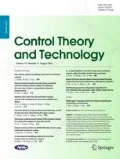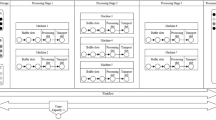Abstract
Operation-related resources are lots of manpower and material with the characteristics of high cost and high income in hospitals, and scheduling optimization is a very important research issue in medical service. In this paper, to cope with the actualities of operation resources scheduling, such as poor planning, lack of standardized scheduling rules, chaotic use of the operating rooms, and many human interference factors, we propose a systematic approach to optimize scheduling problems based on multiple characteristics of operating resources. We first design a framework that includes the composite dispatching rules (CDR), optimization ideology, and feedback mechanism, in which the CDR integrates flexible operating time, hold-up time of medical facilities, available time of medical staff, and multiple constraints. The optimization ideology is carried out through a learning model based on the weighted random forest (WRF) algorithm. The feedback mechanism enables the approach to realize closed-loop optimizations adaptively. Finally, the superiority of the systematic scheduling approach (SSA) is analyzed through numerical experiments on a simulation platform. Results of the simulation experiments show that the proposed scheduling method can improve performances significantly, especially in the waiting time of patients.










Similar content being viewed by others
References
Pinker, E., & Tezcan, T. (2013). Determining the optimal conguration of hospital inpatient rooms in the presence of isolation patients. Operations Research, 61(6), 1259–1276.
Cardoso, T., Oliveira, M. D., Barbosa-Póvoa, A., & Nickel, S. (2016). Moving towards an equitable long-term care network: a multi-objective and multi-period planning approach. Omega, 58, 69–85.
Cardoso, T., Oliveira, M. D., Barbosa-Póvoa, A., & Nickel, S. (2015). An integrated approach for planning a long-term care network with uncertainty, strategic policy and equity considerations. European Journal of Operational Research, 247(1), 321–334.
Xiang, W., Yin, J., & Lim, G. (2015). An ant colony optimization approach for solving an operating room operation scheduling problem. Computers and Industrial Engineering, 85, 335–345.
Silva, T., Souza, M. C., Saldanha, R. R., & Burke, E. K. (2015). Surgical scheduling with simultaneous employment of specialised human resources. European Journal of Operational Research, 245(3), 719–730.
Maenhout, B., & Vanhoucke, M. (2013). An integrated nurse stafng and scheduling analysis for longer-term nursing staff allocation problems. Omega, 41(2), 485–499.
Dios, M., Molina-Pariente, J. M., Fernandez-Viagas, V., Andrade-Pineda, J. L., & Framinan, J. M. (2015). A decision support system for operating room scheduling. Computers and Industrial Engineering, 88, 430–443.
Zhang, L. M., Chang, H. Y., & Xu, R. T. (2013). The patient admission scheduling of an ophthalmic hospital using genetic algorithm. Advanced Materials Research, 756, 1423–1432.
Lu, Y., Xie, X., & Jiang, Z. (2018). Dynamic appointment scheduling with wait-dependent abandonment. European Journal of Operational Research, 265(3), 975–984.
Andersen, A. R., Nielsen, B. F., & Reinhardt, L. B. (2017). Optimization of hospital ward resources with patient relocation using Markov chain modeling. European Journal of Operational Research, 260(3), 1152–1163.
Qi, J. (2016). Mitigating delays and unfairness in appointment systems. Management Science, 63(2), 566–583.
Guo, H., Gao, S., Tsui, K. L., & Niu, T. (2017). Simulation optimization for medical staff conguration at emergency department in Hong Kong. IEEE Transactions on Automation Science and Engineering, 14(4), 1655–1665.
Zhong, X., Li, J., Bain, P. A., & Musa, A. J. (2017). Electronic visits in primary care: modeling, analysis, and scheduling policies. IEEE Transactions on Automation Science and Engineering, 14(3), 1451–1466.
Ahmadi-Javid, A., Jalali, Z., & Klassen, K. J. (2017). Outpatient appointment systems in healthcare: a review of optimization studies. European Journal of Operational Research, 258(1), 3–34.
Huh, W. T., Liu, N., & Truong, V. A. (2013). Multiresource allocation scheduling in dynamic environments. Manufacturing and Service Operations Management, 15(2), 280–291.
Liu, N., Truong, V. A., Wang, X., & Anderson, B. (2019). Integrated scheduling and capacity planning with considerations for patients’ length-of-stays. Production and Operations Management, 28(7), 1735–1756.
Addis, B., Carello, G., Grosso, A., & Tánfani, E. (2016). Operating room scheduling and rescheduling: a rolling horizon approach. Flexible Services and Manufacturing Journal, 28(1–2), 206–232.
Magerlein, J. M., & Martin, J. B. (1978). Surgical demand scheduling: a review. Health Services Research, 13(4), 418–433.
Cardoen, B., Demeulemeester, E., & Beliën, J. (2010). Operating room planning and scheduling: a literature review. European Journal of Operational Research, 201(3), 921–932.
Pham, D. N., & Klinkert, A. (2008). Surgical case scheduling as a generalized job shop scheduling problem. European Journal of Operational Research, 185(3), 1011–1025.
Dexter, F., Wachtel, R. E., & Epstein, R. H. (2016). Decreasing the hours that anesthesiologists and nurse anesthetists work late by making decisions to reduce the hours of over-utilized operating room time. Anesthesia and Analgesia, 122(3), 831–842.
Lamiri, M., Xie, X. L., Dolgui, A., & Grimaud, F. (2008). A stochastic model for operating room planning with elective and emergency demand for operation. European Journal of Operational Research, 185(3), 1026–1037.
Wachtel, R. E., & Dexter, F. (2008). Tactical increases in operating room block time for capacity planning should not be based on utilization. Anesthesia and Analgesia, 106(1), 215–226.
Hans, E., Wullink, G., Houdenhoven, M. V., & Kazemier, G. (2006). Robust surgery loading. European Journal of Operational Research, 185(3), 1038–1050.
Shu, W., & Luo, L. (2008). A surgical scheduling study based on objective programming. Technology and Market, 2, 42–44 (in Chinese).
Zhong, L. W., Luo, S. C., Yang, G. P., Wang, G. Y., Xu, L., Zhao, C. M., & Zhang, P. (2009). Study on surgery scheduling optimization and computer program management in operating room. Journal of Shanghai Second University of Technology, 26(4), 286–290 (in Chinese).
Bai, X., Luo, L., & Li, M. R. (2011). The present situation and development prospect of the study on surgical scheduling in hospital management. Management Review, 23(1), 121–128 (in Chinese).
Kamran, M. A., Karimi, B., & Dellaert, N. (2018). Uncertainty in advance scheduling problem in operating room planning. Computers and Industrial Engineering, 126, 252–268.
Xiao, G., Jaarsveld, W., Dong, M., & Klundert, J. (2016). Stochastic programming analysis and solutions to schedule overcrowded operating rooms in China. Computers and Operations Research, 74, 78–91.
Pang, B., Xie, X., Song, Y., & Luo, L. (2019). Operation scheduling under case cancellation and operation duration uncertainty. IEEE Transactions on Automation Science and Engineering, 16(1), 74–86.
Molina-Pariente, J. M., Fernandez-Viagas, V., & Framinan, J. M. (2015). Integrated operating room planning and scheduling problem with assistant surgeon dependent operation durations. Computers and Industrial Engineering, 82, 8–20.
Erhard, M., Schoenfelder, J., Fügener, A., & Brunner, J. O. (2018). State of the art in physician scheduling. European Journal of Operational Research, 265(1), 1–18.
Qiu, C., Cannesson, M., Morkos, A., Nguyen, V. T., LaPlace, D., Trivedi, N. S., et al. (2016). Practice and outcomes of the perioperative surgical home in a california integrated delivery system. Anesthesia and Analgesia, 123(3), 597–606.
Zhou, L., Geng, N., Jiang, Z., & Wang, X. (2017). Combining revenue and equity in capacity allocation of imaging facilities. European Journal of Operational Research, 256(2), 619–628.
Zhou, L., Geng, N., Jiang, Z., & Wang, X. (2018). Multi-objective capacity allocation of hospital wards combining revenue and equity. Omega, 81, 220–233.
Kim, K., & Mehrotra, S. (2015). A two-stage stochastic integer programming approach to integrated stafng and scheduling with application to nurse management. Operation Researches, 63(6), 1431–1451.
Rath, S., Rajaram, K., & Mahajan, A. (2017). Integrated anesthesiologist and room scheduling for surgeries: Methodology and application. Operation Researches, 65(6), 1460–1478.
Ali, H. H., Lamsali, H., & Othman, S. N. (2019). Operating rooms scheduling for elective surgeries in a hospital affected by war-related incidents. Journal of Medical Systems. https://doi.org/10.1007/s42417-020-00265-8.
Al, R. A., Chen, T., & Judeh, M. (2018). Optimal operating room scheduling for normal and unexpected events in a smart hospital. Operation Researches, 18(3), 579–602.
Park, H. S., Kim, S. H., Bong, M. R., Choi, D. K., Kim, W. J., Ku, S. W., et al. (2020). Optimization of the operating room scheduling process for improving efficiency in a tertiary hospital. Journal of Medical Systems, 44(171), 1–7.
Assad, D. B. N., & Spiegel, T. (2019). Maximizing the efficiency of residents operating room scheduling: a case study at a teaching hospital. Production, 29, e20190025.
Zhou, L. P., Geng, N., Jiang, Z. B., & Wang, X. X. (2020). Public hospital inpatient room allocation and patient scheduling considering equity. IEEE Transactions on Automation Science and Engineering, 17(3), 1124–1139.
Gartnera, D., & Padmanb, R. (2019). Flexible hospital-wide elective patient scheduling. Journal of The Operational Research Society, 71(6), 878–892.
Li, L., Liu, C., Li, F., Zhao, S. Z., & Gong, R. R. (2018). A random forest and simulation approach for scheduling operation rooms: Elective surgery cancelation in a Chinese hospital urology department. International Journal of Health Planning and Management, 33(4), 941–966.
Lapp, L., Bouamrane, M. M., & Kavanagh, K. (2019). Evaluation of random forest and ensemble methods at predicting complications following cardiac surgery. Artificial Intelligence in Medicine, 11526, 376–385.
Lin, K., Hu, Y. H., & Kong, G. L. (2019). Predicting in-hospital mortality of patients with acute kidney injury in the ICU using random forest model. International Journal of Medical Informatics, 125, 53–61.
Acknowledgements
This research was supported by the National Key R&D Program of China (No. 2018YFE0105000), the Shanghai Municipal Commission of Science and Technology (No. 19511132100) and the National Natural Science Foundation of China (No. 51475334).
Author information
Authors and Affiliations
Corresponding author
Rights and permissions
About this article
Cite this article
Li, L., Yu, Q., Shi, H. et al. Support optimal scheduling with weighted random forest for operation resources. Control Theory Technol. 19, 484–498 (2021). https://doi.org/10.1007/s11768-021-00051-1
Received:
Revised:
Accepted:
Published:
Issue Date:
DOI: https://doi.org/10.1007/s11768-021-00051-1




